Scan Lenses for Laser Scanning Microscopy
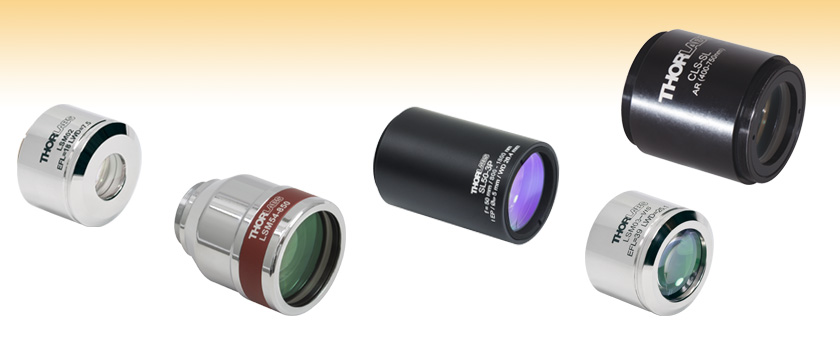
- Telecentric Scanning Lenses with Flat Image Planes
- Mimimal Optical Aberrations and Low F-Theta Distortion
- Large Maximum Fields of View up to 28.9 x 28.9 mm2
- Applications Include OCT, Confocal, and Multiphoton Microscopy
CLS-SL
400 to 750 nm
EFL = 70 mm
LSM03-VIS
400 to 700 nm
EFL = 39 mm
LSM02
1250 to 1380 nm
EFL = 18 mm
SL50-3P
800 to 1800 nm
EFL = 50 mm
LSM54-850
750 to 950 nm
EFL = 54 mm

Please Wait
| Click on the red Document icon next to the item numbers below to access the Zemax file download. Our entire Zemax Catalog is also available. |
Features
- Flat Image Plane
- Minimal Optical Aberration Over Image Plane (See Specs Tab for Details)
- Large Field of View
- Low F-Theta Distortion
- Easily Incorporated into Custom-Built Microscopy Systems
- Dispersion Compensators Available Separately for LSM02(-BB), LSM03(-BB), LSM03-VIS, LSM04(-BB), and LSM05(-BB)
| Scan Lens Quick Links | |
|---|---|
| Wavelength | Item # |
| 400 to 700 nm | LSM03-VIS |
| 400 to 750 nm | CLS-SL |
| 450 to 1100 nm | SL50-CLS2 |
| 680 to 1300 nm | SL50-2P2 |
| 750 to 950 nm | LSM54-850 |
| 800 to 1800 nm | SL50-3P |
| 810 to 890 nm; 1000 to 1100 nm |
LSM02-BB, LSM03-BB, LSM04-BB, and LSM05-BB |
| 950 to 1100 nm | LSM54-1050 |
| 1200 to 1400 nm | LSM54-1310 |
| 1250 to 1380 nm | LSM02, LSM03, LSM04, and LSM05 |
Thorlabs' telecentric scan lenses are ideal for use in laser scanning imaging systems and applications such as Optical Coherence Tomography (OCT), confocal laser scanning microscopy, and multiphoton imaging. Telecentric scan lenses produce a flat image plane and a spot size that suffers minimal distortion as the angle of the incident beam with respect to the optical axis of the lens is varied; varying the angle of incidence causes the focal spot to scan over the field of view in the image plane. A low f-theta distortion creates geometrically correct scanned images that do not require extensive post-image processing. A telecentric scan lens path can also maximize the scattered or emitted light that is captured from the sample (the signal) by the detection system. In addition, the spot size in the image plane is nearly constant over the entire field of view (see Specs tab), resulting in image resolution that varies minimally over the scanned area of the sample.
These scan lenses have center wavelengths that extend from the visible to the near-infrared, and they exhibit a range of effective focal lengths, working distances, and scanning distances (see below and the Specs tab for more information). A selection of these lenses offers fields of view equal to or greater than 18 x 18 mm2, and all possess anti-reflection (AR) coatings designed to minimize back reflections from broadband light sources.
Many confocal imaging systems are designed to operate at visible wavelengths, and the CLS-SL and SL50-CLS2 offer two options for visible confocal laser scanning. The wide wavelength range of the SL50-CLS2 (450 - 1100 nm) makes this lens a good choice for applications involving both multiphoton microscopy and visible photoactivation or targeting. We also offer the SL50-2P2 for two photon microscopy (680 - 1300 nm) as well as the SL50-3P for three-photon microscopy (800 - 1800 nm).
Systems operating in the near-infrared include those designed for confocal, multiphoton, and OCT applications. While the LSM family of lenses listed on this page are optimized for OCT applications, these lenses are also used in confocal, multiphoton and other laser scanning imaging systems. The large 6 mm entrance pupils and ±14° scan angles (single-axis scan) of the LSM54-850, LSM54-1050, and LSM54-1310 scan lenses make them ideal for use with larger galvo mirrors that produce more highly deflected beams. The LSM54-850, LSM54-1050, and LSM54-1310 scan lenses have also been optimized to provide a flat field of view, and they are corrected for chromatic aberrations across their wide 200 nm band of operating wavelengths.
Thorlabs' scan lenses and tube lenses are individually corrected for aberrations, and any of these scan lenses may be paired with a tube lens that is also corrected for aberrations.
Click on the links in the table to the right to jump to lenses of interest, or scroll down the page.
Specifications
The complete specifications available for each scan lens are provided in the tables below, and definitions of the various parameters follow the tables. Click the blue icons, ![]() , to view the plots. All plots below show theoretical data.
, to view the plots. All plots below show theoretical data.
Lenses with Wavelength Ranges Starting Between 400 and 450 nm
Lenses with Wavelength Ranges Starting Between 680 and 810 nm
Lenses with Wavelength Ranges Starting Between 800 and 1250 nm
Definitions of Key Parameters

Scanning Distance (SD): The SD is the distance between the aperture plane, where the EP lies, and the back mounting plane of the objective, which is defined as the base of the mounting threads. For these lenses, the mounting plane is the shoulder adjacent to the threads, or thread mounting plane, of the lens. When two galvo mirrors are used, the aperture plane occurs midway between the two mirrors. When one galvo mirror is used, the pivot point of the single mirror coincides with the aperture plane. See the Application Info tab for more details.
Scan Angle (SA): After being routed from the galvo mirror(s) the laser beam is incident on the lens at an angle. This angle, measured with respect to the optical axis of the lens, is the scan angle. When listed in the specification table, it indicates the range of maximum allowed scan angles.
Parfocal Distance (PD): The PD is the distance from the scan lens mounting plane to the front focal plane of the scan lens.
Working Distance (WD or LWD): The distance between the tip of the scan lens housing and the front focal plane of the scan lens is defined as the WD.
Field of View (FOV): The FOV is the maximum size of the area on the sample that can be imaged with a resolution equal to or better than the stated resolution of the scan lenses. This assumes the proper utilization of the scan lenses in the optical system. During operation, the spot positions scan through the FOV.
Depth of View (DOV): The DOV parameter corresponds to the distance between the parallel planes on either side of the front focal plane where the beam spot diameter is √2 greater than it is at the front focal plane. This parameter is of interest when tube lenses are not used in the optical system design and the front focal place is also the sample plane, as is generally the case for OCT. When a tube lens is paired the scan lens, the image plane is located between the scan and the tube lens; the depth of field at the sample is then controlled by the microscope objective.
Spot Size Data
Spot sizes formed in the image plane are typically of more interest to OCT system design than to other laser scanning microscopy system designs. This is because in most OCT systems the image plane is also the sample plane. In other laser scanning applications, scan lenses are routinely paired with tube lenses and the image plane of the scan lens does not coincide with the sample plane.
Spot size plots for these lenses may be viewed by clicking on the blue icons, ![]() , in the preceding tables. Spot size data are calculated for simulated two-axis and single-axis scans; for the two-axis case a system with two galvo mirrors is simulated, and for the single-axis case a system with a single galvo mirror is simulated. The location of the entrance pupil, which is positioned at the aperture plane, varies depending on whether one or two mirrors are used. When two galvo mirrors are used, the aperture plane is located midway between two galvo mirrors, as is shown in the right image of the Application Info tab. When a single galvo mirror is used, the aperture plane falls at the pivot point of the mirror, as is shown in the left image of the Application Info tab.
, in the preceding tables. Spot size data are calculated for simulated two-axis and single-axis scans; for the two-axis case a system with two galvo mirrors is simulated, and for the single-axis case a system with a single galvo mirror is simulated. The location of the entrance pupil, which is positioned at the aperture plane, varies depending on whether one or two mirrors are used. When two galvo mirrors are used, the aperture plane is located midway between two galvo mirrors, as is shown in the right image of the Application Info tab. When a single galvo mirror is used, the aperture plane falls at the pivot point of the mirror, as is shown in the left image of the Application Info tab.
The two-axis scan gives detailed information about the variation in spot size and spot position over an entire two-dimensional range of scan angles; spot sizes over entire image plane are plotted. These data are calculated for a single wavelength (the center wavelength of the lens) and presented as a 3D plot, with the spot size data plotted on the vertical axis.
The 2D single-axis scan graph contains three curves corresponding to: the center wavelength, the minimum specified wavelength, and the maximum specified wavelength. Together they illustrate the dependence of spot size on wavelength. The single-axis scan graphs plot spot size and spot position over a one-dimensional range of scan angles; the spot positions scan a line through the image plane. Because the aperture plane is not located in the same place for the Two-Axis and Single-Axis Scan plots, the data in the Single-Axis plot is not an exact cross section of the Two-Axis Scan plot data. The single-axis scan data were simulated using a system focused at the center wavelength of the lens; the system was not individually focused at each of the three wavelengths.
Scan lenses are used in a variety of laser imaging systems, including confocal laser scanning microscopy, optical coherence tomography (OCT), and multiphoton imaging systems. In these applications, a laser beam incident on the back aperture (entrance pupil) of the lens is scanned through a range of angles. This translates the position of the spot formed in the image plane across the lens' field of view. In the case of non-telecentric lenses, this approach to scanning the focal spot through the image plane would introduce severe aberrations that would significantly degrade the quality of the resulting image. Telecentric scan lenses are designed to create a uniform spot size in the image plane at every scan position, which allows a high-quality image of the sample to be formed. Plots showing the spot size and scan position as a function of scan angle are included in the Specs tab.
In general, laser scanning microscopy systems pair a scan lens with a tube lens to create an infinity-corrected optical system. However, most OCT systems are designed to use the scan lens without a tube lens. The CLS-SL, SL50-CLS2, SL50-2P2, and SL50-3P lenses were optimized for use in Thorlabs' confocal laser scanning and multiphoton microscopy systems, and the LSM family of lenses were optimized to be used in OCT imaging systems. A brief discussion of scanning systems implemented with and without tube lenses follows.

Click to Enlarge
The tube and scan lens schematic above shows the lens spacing for the SL50-CLS2 scan lens used with a 200 mm focal length telecentric tube lens. Note that for the SL50-CLS2, the entrance pupil at the scan plane is a maximum of Ø4 mm.
Scan Lenses Implemented in General Laser Scanning Microscopy Applications
The image to the right shows the proper spacing of the scan and tube lenses for laser scanning microscopy. The scanning mirror, which is located at the left of the image at the scan plane, directs the laser beam through the scan lens. The angle at which the laser beam is incident on the scan lens determines the position of the focal spot in the intermediate image plane, which is located between the scan lens and the TTL200MP tube lens. The tube lens is positioned so that it collects and collimates the light (the focus is at infinity). The collimated light is collected by the objective, which brings it to a focus on the sample plane. Light scattered or emitted from the sample plane is collected by the objective and directed to a detector. The image below and to the left shows a CLS-SL scan lens paired with a tube lens; clicking on the image shows the correct spacing for using the CLS-SL with the ITL200 tube lens.
An attractive feature of this optical system design is the collimated light that is produced as a result of pairing the scan lens with the tube lens. With the light from the tube lens focusing at infinity, it is possible to move the position of the objective with respect to the tube lens without impacting the image quality at the sample plane. This imparts considerable flexibility to the design of the optical system. If no tube lens were used, the scan lens would also function as the objective and the intermediate image plane would become the sample plane. It would not be possible to move the image plane much with respect to the scan lens while maintaining image quality.
The image below and to the right shows the relationship between the scan distance and the objective distance. In a perfect 4f optical system (using the CLS-SL as an example), d1 = 52 mm (minimum scan distance) and d2 = f2. However, in many practical cases the system is slightly deviated from this perfect alignment. For instance, in many commercial microscopes, the objective distance (d2) is not the same as the focal length (f2), so there may be a need to adjust distances. The figure below and to the right shows the scan and objective distance moved by some small distance δ1 and δ2, respectively. The relationship between these values is δd1 = -δd2*(f1/f2)2.

Click for Details
CLS-SL Tube Lens integration with the ITL200 and an objective in a laser scanning system.
Scan Lenses Implemented in OCT
When designing an imaging system that uses an LSM scan lens in an OCT configuration, it is important to accommodate the design wavelength, parfocal distance, scanning distance, entrance pupil, and scan angle specifications in order to maximize the image quality (see the Specs tab for scan lens specifications and definitions). In general, the larger the input beam diameter, the smaller the focused spot size. However, due to the effects of vignetting and/or increased aberrations, the range of scan angles decreases as the diameter of the beam increases. Beams smaller than the entrance pupil specification will result in spot sizes larger than those specified in the Specs tab, and beams with larger diameters will be clipped.
For imaging systems with a single galvo mirror the center of the scan lens' entrance pupil is coincident with the pivot point of the galvo mirror. When a single galvo mirror is used, the scanning distance is measured from the mounting surface of the lens to the pivot point of the mirror. This is shown in the image at bottom-left.
If the imaging system uses two galvo mirrors (one to scan in the X direction and one to scan in the Y direction), the entrance pupil is located between the two galvo mirrors, as is shown in the image at bottom-right. The scanning distance is then the distance from the mounting surface of the lens to the pivot point of the mirror closest to the lens (d1) plus the distance from the pivot point of that mirror to the entrance pupil (d2). It is important to minimize the distance between the two galvo mirrors, because when the entrance pupil and beam steering pivot point are not coincident, the quality of the image is degraded. This is principally due to the variation in the optical path length as the beam is scanned over the sample. Below are schematics for an imaging system containing one and two galvo mirrors.

When one galvo mirror is used, the entrance pupil is located
at the pivot point of the mirror.

When two galvo mirrors are used, the entrance pupil is located between the mirrors.
| Posted Comments: | |
Marijn Siemons
(posted 2020-08-19 09:50:09.83) Hi!
I have a question about the LSM03-VIS.
What is the transmission of this lens? Most other lenses appear to have a specification for this, but the CLS-SL unfortunately not.
I'm looking forward the answer.
regards,
Marijn YLohia
(posted 2020-09-24 04:04:38.0) Hello Marijn, thank you for contacting Thorlabs. Unfortunately, we do not have transmission information for the LSM03-VIS at the moment. We do, however, offer the reflectance information on this page. We hope to add the transmission data to the website in the future. Christian Maibohm
(posted 2020-07-22 10:32:57.027) Dear Thorlabs,
We would like to use the SL50-CLS2 together with the TTL200MP tube lens for a scanning laser microscope with sub 10 fs pulses. Is it possible to get information regarding the glass thickness and material as well as the second + third order dispersion induced by this lens set?
Thank you in advance, Christian Maibohm asundararaj
(posted 2020-08-17 04:38:37.0) Thank you for contacting Thorlabs. While the glass material and thickness of these components is proprietary, the black box zemax files are available which can be used to estimate performance. I have contacted you about the dispersion info for the SL50-CLS2 via email. Alex Bouhelier
(posted 2020-03-26 05:04:15.337) Hello,
I am looking to retrofit your 2D large beam Galvo system with a NIKON TE 2000 equipped with a high NA objective (60X, NA 1.49, entrance pupil=9 mm). I am considering the telecentric system composed of the tube lens (TL200) and the scan lens (SL50). I have a concern about the entrance pupil of the scan lens (4 mm)n which will severely limit the diameter of the laser beam entering the objective. This will reduce the resolution of the microscope, since the entrance pupil of the objective will be underfilled. What is your recommendation? YLohia
(posted 2020-03-26 10:43:37.0) Hello, thank you for contacting Thorlabs. The final resolution will be limited by the optic that is the weakest link in your optical system. The scan lenses will inherently lower the resolution possible since the beam is scanned through a range of angles over the back aperture (so it is not possible to fully fill the entrance pupil of your objective with the beam). Additionally, the lens design is optimized for flat-field scanning and chromatic performance, but not diffraction limited focus spot size. You may achieve higher resolution by using the LSM05-BB instead, which has a larger entrance pupil diameter, if it falls within your wavelength range. The Spot Size vs Scan Angle plot for this lens can be found in the Specs tab : https://www.thorlabs.com/images/TabImages/LSM05-BB_850nm_Spot_Size_Single_Axis_Scan_A1-800.gif. Enoch Hong
(posted 2020-01-06 21:15:57.12) Is it possible to use this lens directly without any other optical component for coaxial imaging (w/ CCD) and laser scanning? YLohia
(posted 2020-01-09 08:31:55.0) Thank you for contacting Thorlabs. In general, it is possible to use the LSM03-VIS for laser scanning applications. I have reached out to you directly to discuss your specific requirements to determine the suitability of this lens for your application. Eric Yang
(posted 2019-09-23 20:33:29.853) 如果将LSM05-BB应用于激光切割,损伤阈值大概多少? YLohia
(posted 2019-09-23 12:38:48.0) Hello, thank you for contacting Thorlabs. One of our Applications Engineers from our Thorlabs China Group (techsupport-cn@thorlabs.com) will reach out to you directly. x.attendu
(posted 2019-02-14 11:54:00.58) Dear Sir/Madam,
I am wondering if it is possible to implement the SL50-CLS2 in an OCT setup. This lens would be used directly as the scan lens without any other optical component in a setup similar to the ones presented in the 'scan lenses implemented in OCT' in the application info tab. llamb
(posted 2019-02-18 02:56:39.0) Thank you for contacting Thorlabs. In general, you may use the SL50-CLS2 in an OCT setup without other optical components, but your Field of View will be quite truncated. We will reach out to you by email to discuss your application further. benju
(posted 2018-09-24 13:00:48.367) Was there a mistake in the two-axis spot size simulation? It should be rotation symmetric, no? The plot looks more like a square / 4-sided symmetry. YLohia
(posted 2018-09-27 08:31:47.0) Hello, thank you for contacting Thorlabs. The plot is based on a two-galvo-scanning system with a certain mirror separation. That causes the rectangular scan area and the symmetry characteristic. The reason for the shown symmetry is the moving aperture plane position for different x & y image coordinates, and the different aberrations for that aperture position. akbar.khodaei
(posted 2018-03-03 10:57:03.457) Hi,
What makes such huge price difference between TTL200MP and TL200-CLS2?
If the difference in scan angel makes this price difference, how much is the maximum scan angle of each of them?
Thanks. nbayconich
(posted 2018-04-24 03:26:46.0) Thank you for contacting Thorlabs. Both of these tube lenses have identical performance in terms of field of view, the ±11mm FOV for TTL200MP is the radial field of view (22mm diameter circle) which translates to a 16.3mm x 16.3mm square field of view. The working distance and AR coating will be slightly different between these two lenses and the high cost comes from the lens material used in the TTL200-CLS2. In terms of performance the TTL200MP will perform just as well as the TTL200-CS. matz.liebel
(posted 2017-08-16 16:00:56.873) Same question as mcravenc I am looking for the Zemax blackbox (mirrored and normal) files for:
LSM03-VIS
Maybe you could just upload them here so the next person doesn't have to post again. tfrisch
(posted 2017-08-28 10:37:38.0) Hello, thank you for contacting Thorlabs. For now, I will reach out to you directly with the reverse file, and the forward version is already posted on the web. I'll talk to our design and marketing teams about posting them. mcravenc
(posted 2016-12-06 12:16:50.693) Please provide the mirror space Zemax blackbox files for the LSM54-1050 and the LSM54-850. This would be enormously helpful to microscope design. Without the mirror space blackbox file, users cannot model confocal or two-photon microscopes. tfrisch
(posted 2016-12-06 01:32:40.0) Hello, thank you for contacting Thorlabs. I will reach out to you directly about these Zemax files. ludoangot
(posted 2016-09-19 11:01:59.59) Hello, can these lenses be used for non-scanning imaging? I mean by this to use them to directly obtain an image of a sample on a camera sensor plane rather than scanning a laser beam on the sample. What would be the drawback(s) in doing so (maybe the spot size and the chromatic aberration)? jlow
(posted 2016-09-20 03:46:51.0) Response from Jeremy at Thorlabs: There are a few main concerns for imaging with these objectives. The chromatic correction is not optimized for visible region. The AR coatings (except for the two visible ones) are not optimized for visible region. These lens are also telecentric so it offers no depth perspective your samples. mikhail.mazurenka
(posted 2016-04-21 13:45:31.207) Dear Sir or Madam
Could you please tell me the NA of the LSM03 lens.
Best regards,
Mikhail besembeson
(posted 2016-04-21 02:00:09.0) Response from Bweh at Thorlabs USA: You can't really define the NA of a scan lens. You could look at this in multiple ways. If you are looking at the input to the lens from a scanning mirror, then you may use the scan angle of 7.5deg to determine a numerical aperture but this will be beam diameter dependent. At the image side, you could use the effective focal and the ideal collimated beam diameter (or pupil size) of 4mm to estimate a numerical aperture. loic.morvan
(posted 2015-12-03 13:49:22.8) Hello,
we would like to interface one of the LSM04-BB, on the angle scanning side (threaded), to a vacuum box.
To this aim, we would like to know :
- the material and thickness of the last element on the angle scan side,
- if it is possible to dismantle the threaded part in order to add something to make it hermetic.
Additionally, we work at a specific wavelength. would it be possible to have a custom version with an AR coating optimized to this wavelength, to minimize ghosts ?
do not hesitate to contact me directly by email.
Many thanks besembeson
(posted 2015-12-03 11:09:02.0) Response from Bweh at Thorlabs USA: Thanks for contacting Thorlabs. I will follow up with you to discuss your application further and provide the special quotation. nmorel
(posted 2015-11-09 11:23:11.473) Can you tell me the material for LSM02-BB? smcelwee
(posted 2015-11-12 05:32:35.0) Response from Sean M at Thorlabs USA: Thank you for your feedback. I will contact you directly to get details about your application and provide the material information. valdemar.s
(posted 2015-08-10 01:36:32.03) Dear to whom ir concern,
We are interested on laser scanning application for laser microfabrication with your scan lens CLS-SL, tube lens ITL200 and LSM03-VIS objective.
Would it be acceptable to use these components with picosecond up to 5 W averagepower laser. What is maximum allowable damage threshold for these optical components?
Best regards,
Valdemar Stankevič
Engineer & Project manager besembeson
(posted 2015-09-29 05:35:49.0) Response from Bweh at Thorlabs USA: We don't have these damage threshold values for these lenses. I will follow-up to determine if your peak powers can still be okay for these components. thomas.liebig
(posted 2015-06-01 11:33:12.02) Dear sir/madam,
the zemax file of LSM05-BB seems to be the one of LSM05. Eventhough it is named correctly, after opening the title of the lens is LSM05 and the wavelength specified is 1315nm insted of the BBs 850nm & 1050nm. I would like to receive the correct ZMX file rather soon if possible.
Sincerely
Thomas Liebig myanakas
(posted 2015-06-12 11:30:11.0) Response from Mike at Thorlabs: Thank you for your feedback. The LSM05 and LSM05-BB are the same with exception to the coating. We are working on updating the Zemax files to include the different coating. However, in the meantime, the wavelength can be changed within the file by going to “System” and then “Wavelength Data”. papour
(posted 2015-03-27 11:42:32.067) The LSM04 was shipped in a plastic bag- this is not ideal for lenses in general. Would be better to get it in a plastic rigid box such that the lens surfaces are better protected (as most objective lenses are stored and shipped). besembeson
(posted 2015-04-03 03:07:44.0) Response from Bweh at Thorlabs USA: Thanks for the feedback. We will review our packaging process for these to protect the lens surface better. If your unit came with any scratches, we will replace this for you. user
(posted 2015-03-16 01:35:28.853) "The shorter the distance between the tube lens and the objective, the longer the scanning position."
What is meant by "scanning position" in this statement? Isn't the scanning position determined by the working distance of the objective lens? myanakas
(posted 2015-03-23 12:56:25.0) Response from Mike at Thorlabs: Thank you for your feedback. The scanning position is defined as the distance from the scanning mirror to the end of the externally threaded region on the scan lens housing. This can be seen in the “Application info” tab or in the enlarged image in the “Visible Scan Lens for Laser Scanning Microscopy” grouping. In a 4f optics system the distance from the tube lens to the objective will be f2, or the focal length of the tube lens. However, this is rarely the case in an imaging system. When the objective is moved from this position the scan lens will also have to shift to compensate for this. When the objective is moved further from the tube lens the scanning position will decrease, and vice versa. We are currently working on updating this presentation to make this more clear. jessie.weber
(posted 2014-07-22 15:38:10.96) On the Specs tab in the "Scan Lenses for Laser Scanning Microscopy" page, the mean spot size for this lens is reported in the table "1315 nm OCT Scan Lenses" as 23.5um. However, in the graphs tab, the spot sizes shown for 1315nm are 65-67um. Is this an error? Could you confirm the mean spot size for this lens?
Thank you. myanakas
(posted 2014-07-23 09:23:47.0) Response from Mike at Thorlabs: Thank you for your feedback. The mean spot size in the table within the “Specs” tab is valid for an entrance beam diameter of 8 mm. The graph is showing the spot size for a single mode fiber that is being collimated with an asphere. This provides an entrance beam diameter of approximately 4 mm. Both mean spot sizes are correct, but they are for different entrance beam diameters. We will update the website to make this more clear. jason.tan
(posted 2014-02-26 16:04:28.157) Hi
I have had a question, is LSM03 can replace the ITL200?
(I want the low EFL tube lens(EFL> 100mm).
what do you suggest ?
thanks for paying attention. besembeson
(posted 2014-02-28 04:47:36.0) Response from Bweh E at Thorlabs: Thanks for contacting Thorlabs. The LSM03 is generally used in laser imaging system and scanning applications. The ITL200 is typically used for camera imaging in conjunction with an objective. These are the optimal ways of using these components. I will send you separate email to discuss your application further so that we can decide on optimal components for you. mgg6
(posted 2013-09-05 23:30:06.82) The zemax model files for the LSM03-BB and LSM03 are identical (same MD5sum). Is this correct and the two products are actually identical optically aside from the AR coating, or were the wrong model files uploaded? sharrell
(posted 2013-09-06 11:10:00.0) Response from Sean at Thorlabs: Thank you for using our feedback form. These two lenses are identical except for the coating. Since the coating information was not included in the Zemax files, the models are identical. sharrell
(posted 2012-08-16 08:42:00.0) Response from Sean at Thorlabs: Thank you for your feedback. I am sorry that these files have been unavailable. We are in the process of updating our website with the .zar files for these products, which is what we now use as the standard provided format. These files will be available on the web later today, and I have sent you the files for the requested products directly. loic.morvan
(posted 2012-08-16 08:23:19.0) Hello,
Im interested in having the zemax models (even in "black box" form) for LM02-BB, LM03-BB, LM004-BB and LM-05BB.
Thank you by advance bdada
(posted 2012-02-06 14:55:00.0) Response from Buki at Thorlabs:
Thank you for participating in our feedback forum. We are looking into your request and will contact you with more information. anup.katake
(posted 2012-02-03 13:28:23.0) Hello,
To incorporate the LSM-02 lens in the design, will it be possible for you to send the zemax design file for it?
Also, what would happen if I use the lens at 1550nm?
Thanks bdada
(posted 2011-07-21 13:49:00.0) Response from Buki at Thorlabs:
We do not currently offer the scan lenses designed for visible wavelengths. We have contacted you to learn more about your application and to see if another of our objective lenses could be suitable for your application. bdada
(posted 2011-07-21 13:43:00.0) Response from Buki at Thorlabs:
Thank you for your feedback. Please review the excerpt below that is in the write up in the "Application Info" tab:
"It is important to minimize the distance between the two galvo mirrors, because when the entrance pupil and beam steering pivot point are not coincident, the quality of the image is degraded. This is principally due to the variation in the optical path length as the beam is scanned over the sample."
Please contact TechSupport@thorlabs.com if you have further questions concerning this or if you want to discuss your application. user
(posted 2011-07-21 11:08:22.0) In the "Application Info" I can read this: "The maximum recommended separation between the two
galvo mirrors is 8 mm." Why is there a maximum separation? Thank you. ykpark76
(posted 2011-07-20 22:30:45.0) Can I use these Scan lenses at visible range?
Or Can you make a Scan lens for visible range?
(For example, 530nm ~ 700nm) bdada
(posted 2011-04-14 10:01:00.0) Response from Buki at Thorlabs to Edgar:
Thank you for your feedback. We have contacted you with the Zemax black box files. Please contact TechSupport@thorlabs.com if you have further questions. edgar.guevara
(posted 2011-04-12 16:08:02.0) Could you post the full ZEMAX data (.zmx) for LSM04? I think it would be very useful for all the users who want to optimize the spot
profiles over the entire scanning range. boris.povazay
(posted 2010-11-26 07:24:49.0) Would it be possible to indicate the focal lengths, versus scanning angle also for the 800 +/- 150 and 1060 +/-70nm range? (or even better the focal shift versus wavelength for a set of angles/object sizes)
Are designs with a wider field of view (~50mm) planned.
Best regards! |

- Design Optimized for OCT Imaging Systems
- Entrance Pupil: 4 mm
- Scan Angle Range: ±10.6° (Maximum, Single Axis)
- External M25 x 0.75 Mounting Threads
While this lens design is optimized for OCT imaging, it may also be used in a variety of laser scanning microscopy applications. The LSM03-VIS scan lens is designed and AR coated for imaging over the visible wavelength range (400 to 700 nm). Key specifications for this lens are listed to the right; see the Specs tab for complete specifications.
The external M25 x 0.75 threading can be adapted to Thorlabs' standard SM1 (1.035"-40) threading by using an SM1A12 adapter. An RMSA2 adapter allows the scan lens to be used with RMS-threaded (0.800"-36) components.
For OCT imaging systems that utilize this scan lens as a primary objective element, we offer the LSM03DC-VIS dispersion compensator.

- Design Optimized for Confocal Laser Scanning Microscopy Systems
- Entrance Pupil: 4 mm
- Large Maximum Field of View: 19 x 19 mm2
- External SM2 (2.035"-40) Mounting Threads
The CLS-SL scan lens is designed and AR coated for point-by-point laser scanning imaging over the visible wavelength range (400 to 750 nm). This scan lens, originally designed for Thorlabs' Confocal Laser Scanning Microscopy Systems, can be easily integrated into customer-designed laser scanning systems using the external SM2 (2.035"-40) threads on both ends. We recommend pairing this scan lens with our ITL200 tube lens and one of our objectives.
Please note that even though the CLS-SL has a symmetric housing, it is not bi-directional. When the housing's engraving is right-side-up, the light should enter the lens from the top. For additional specifications, please see the Specs tab.

- Design Optimized for Laser Scanning Microscopy Systems
- Telecentric When Paired with a TTL200MP Tube Lens
- Entrance Pupil: 4 mm
- Large Maximum Field of View: 14.1 x 14.1 mm2 for 656.6 - 1100 nm
- External SM30 (M30.5 x 0.5) Mounting Threads
The SL50-CLS2 scan lens is designed and AR coated for point-by-point laser scanning imaging over the visible and NIR wavelength ranges (450 - 1100 nm). This broad wavelength range enables applications involving both multiphoton microscopy and visible photoactivation or targeting. This scan lens can easily be integrated into customer-designed systems using the external SM30 mounting threads on one end. The SM2A11 internal SM30 to external SM2 (2.035"-40) adapter is available for adapting this lens to our SM2 lens tubes. This lens is designed to be telecentric when paired with a TTL200MP tube lens and one of our objectives, as shown in the diagram on the Application Info tab.
The housing is engraved with an arrow next to the text "EP" (Entrance Pupil) indicating the end of the housing that should face the scanning system.

- Design Optimized for Two-Photon Laser Scanning Microscopy Systems
- Telecentric When Paired with a TTL200MP Tube Lens
- Entrance Pupil: Up to 5 mm
- Large Maximum Field of View: 14.1 x 14.1 mm2 from 1000 to 1300 nm
- External SM30 (M30.5 x 0.5) Mounting Threads
The SL50-2P2 scan lens is designed and AR coated for point-by-point laser scanning imaging over the NIR wavelength range (680 - 1300 nm). This scan lens is used in our Bergamo® Multiphoton Imaging Microscope and can easily be integrated into customer-designed systems using the external SM30 mounting threads on one end. The SM2A11 internal SM30 to external SM2 (2.035"-40) adapter is available for adapting this lens to our SM2 lens tubes. This lens is designed to be telecentric when paired with a TTL200MP tube lens and one of our objectives, as shown in the diagram on the Application Info tab.
The housing is engraved with an arrow next to the text "EP" (Entrance Pupil) indicating the end of the housing that should face the scanning system.

- Design Optimized for OCT Imaging Systems
- Large Entrance Pupil: 6 mm
- Wide Scan Angle Range: ±14.0° (Maximum, Single Axis)
- Large Maximum Field of View: 18.8 x 18.8 mm2
- Minimum Spot Size: 14 µm at 850 nm (See Table at Right)
While the LSM54-850 lens is optimized for OCT imaging, it may also be used in a variety of laser scanning microscopy applications. Compared with many of our other LSM scan lenses, the LSM54 lenses, with their larger entrance pupils and range of scan angles, offer better compatibility with galvo mirrors that are larger and produce more highly deflected beams. Other features made possible through optimized optical design and an increased number of refractive elements include improved chromatic correction and the ability to operate over a wide spectral range. For systems operating in the 950 to 1150 nm or 1200 to 1400 nm wavelength ranges, the LSM54-1050 or LSM54-1310 lenses, respectively, provide similar performance.
The table at right includes key specifications for the LSM54-850 lens, including a representative plot showing the small spot size and the spot position in the image plane as a function of all scanned angles at a wavelength of 850 nm. Click on the blue icons, ![]() , to view the spot size and transmittance plots. For additional specifications, please see the Specs tab.
, to view the spot size and transmittance plots. For additional specifications, please see the Specs tab.
The external M25 x 0.75 threading can be adapted to Thorlabs' standard SM1 (1.035"-40) threading by using an SM1A12 adapter. An RMSA2 adapter allows the scan lens to be used with RMS-threaded (0.800"-36) components.
For OCT imaging systems that utilize this scan lens as a primary objective element, we offer the LSM54DC1 dispersion compensator.

- Designed for Three-Photon Laser Scanning Microscopy Systems
- Entrance Pupil: Up to 5 mm
- Large Maximum Field of View: 14.1 x 14.1 mm2 from 1000 to 1800 nm
- External SM30 (M30.5 x 0.5) Mounting Threads
The SL50-3P scan lens is designed and AR coated for point-by-point laser scanning imaging over the NIR wavelength range (800 - 1800 nm). This scan lens is used in our Bergamo® Multiphoton Imaging Microscope and can easily be integrated into customer-designed systems using the external SM30 mounting threads on one end. The SM2A11 internal SM30 to external SM2 (2.035"-40) adapter is available for adapting this lens to our SM2 lens tubes. The Application Info tab provides details on pairing scan lenses and tube lenses.
The housing is engraved with an arrow next to the text "EP" (Entrance Pupil) indicating the end of the housing that should face the scanning system.

| Key Specificationsa,b | ||||
|---|---|---|---|---|
| Item # | LSM02-BB | LSM03-BB | LSM04-BB | LSM05-BB |
| Wavelength Range | 810 to 890 nm and 1000 to 1100 nm |
|||
| Effective Focal Length | 18 mm | 36 mm | 54 mm | 110 mm |
| Lens Working Distance | 7.5 mm | 25 mm | 42 mm | 94 mm |
| Field of View, Maximum | 4.7 x 4.7 mm2 | 9.4 x 9.4 mm2 | 14.1 x 14.1 mm2 | 28.9 x 28.9 mm2 |
| Field of View, Diffraction Limited |
3.2 x 3.2 mm2 (850 nm) 3.7 x 3.7 mm2 (1050 nm) |
7.9 x 7.9 mm2 (850 nm) 8.6 x 8.6 mm2 (1050 nm) |
14.1 x 14.1 mm2 (850 nm) 14.1 x 14.1 mm2 (1050 nm) |
18.8 x 18.8 mm2 (850 nm) 21.1 x 21.1 mm2 (1050 nm) |
| Spot Size Plot, 850 nm (Two-Axis Scan) |
||||
| Spot Size Plot, 1050 nm (Two-Axis Scan) |
||||
| Reflectance | ||||
| Mounting Threads (External) | M25 x 0.75 | SM2 (2.035"-40) | ||
| Dispersion Compensator | LSM02DC | LSM03DC | LSM04DC | LSM05DC |
| Storage Casec | Lid: OC2M25 Canister: OC22 |
N/A | ||
- Design Optimized for OCT Imaging Systems
- Center Wavelengths at 850 and 1050 nm
- Scan Angle Range: ±10.6° (Maximum, Single Axis)
- Range of Effective Focal Length Options from 18 to 110 mm
These lenses have been optimized for OCT imaging, but they may also be used in a variety of laser scanning microscopy applications. The performance of these lenses has been optimized for wavelength bands around 850 and 1050 nm, two popular wavelengths for OCT. For additional specifications, please see the Specs tab.
The external M25 x 0.75 threading can be adapted to Thorlabs' standard SM1 (1.035"-40) threading by using an SM1A12 adapter. An RMSA2 adapter allows the scan lens to be used with RMS-threaded (0.800"-36) components.
For OCT imaging systems that utilize this scan lens as a primary objective element, we offer matched dispersion dispersion compensators for each scan lens; see the table to the right.
Note: The Zemax files for LSM0x and LSM0x-BB lenses are identical because they do not include coating information. Therefore, the files are the same regardless of the -BB suffix at the end of the item #.

- Design Optimized for OCT Imaging Systems
- Large Entrance Pupil: 6 mm
- Wide Scan Angle Range: ±14.0° (Maximum, Single Axis)
- Large Maximum Field of View: 18.8 x 18.8 mm2
- Minimum Spot Size: 18 µm at 1050 nm (See Table at Right)
While the LSM54-1050 lens is optimized for OCT imaging, it may also be used in a variety of laser scanning microscopy applications. Compared with many of our other LSM scan lenses, the LSM54 lenses, with their larger entrance pupils and range of scan angles, offer better compatibility with galvo mirrors that are larger and produce more highly deflected beams. Other features made possible through optimized optical design and an increased number of refractive elements include improved chromatic correction and the ability to operate over a wide spectral range. For systems operating in the 750 to 850 nm or 1200 to 1400 nm wavelength ranges, the LSM54-850 or LSM54-1310 lenses, respectively, provide similar performance.
The table at right includes key specifications for the LSM54-1050 lens, including a representative plot showing the small spot size and the spot position in the image plane as a function of all scanned angles at a wavelength of 1050 nm. Click on the blue icons, ![]() , to view the spot size and transmittance plots. For additional specifications, please see the Specs tab.
, to view the spot size and transmittance plots. For additional specifications, please see the Specs tab.
The external M25 × 0.75 threading can be adapted to Thorlabs' standard SM1 (1.035"-40) threading by using an SM1A12 adapter. An RMSA2 adapter allows the scan lens to be used with RMS-threaded (0.800"-36) components.
For OCT imaging systems that utilize this scan lens as a primary objective element, we offer the LSM54DC2 dispersion compensator.

- Design Optimized for OCT Imaging Systems
- Large Entrance Pupil: 6 mm
- Wide Scan Angle Range: ±14.0° (Maximum, Single Axis)
- Large Maximum Field of View: 18.8 x 18.8 mm2
- Minimum Spot Size: 22 µm at 1300 nm (See Table at Right)
While the LSM54-1310 lens is optimized for OCT imaging, it may also be used in a variety of laser scanning microscopy applications. Compared with many of our other LSM scan lenses, the LSM54 lenses, with their larger entrance pupils and range of scan angles, offer better compatibility with galvo mirrors that are larger and produce more highly deflected beams. Other features made possible through optimized optical design and an increased number of refractive elements include improved chromatic correction and the ability to operate over a wide spectral range. For systems operating in the 750 to 850 nm or 950 to 1150 nm wavelength ranges, the LSM54-850 or LSM54-1050 lenses, respectively, provide similar performance.
The table at right includes key specifications for the LSM54-1310 lens, including a representative plot showing the small spot size and the spot position in the image plane as a function of all scanned angles at a wavelength of 1310 nm. Click on the ![]() ,
,
The external M25 × 0.75 threading can be adapted to Thorlabs' standard SM1 (1.035"-40) threading by using an SM1A12 adapter. An RMSA2 adapter allows the scan lens to be used with RMS-threaded (0.800"-36) components.
For OCT imaging systems that utilize this scan lens as a primary objective element, we offer the LSM54DC3 dispersion compensator.

| Key Specificationsa,b | ||||
|---|---|---|---|---|
| Item # | LSM02 | LSM03 | LSM04 | LSM05 |
| Wavelength Range | 1250 to 1380 nm | |||
| Effective Focal Length | 18 mm | 36 mm | 54 mm | 110 mm |
| Lens Working Distance | 7.5 mm | 25.1 mm | 42.3 mm | 93.8 mm |
| Field of View, Maximum | 4.7 x 4.7 mm2 | 9.4 x 9.4 mm2 | 14.1 x 14.1 mm2 | 28.9 x 28.9 mm2 |
| Field of View, Diffraction Limited |
4.2 x 4.2 mm2 | 9.3 x 9.3 mm2 | 14.1 x 14.1 mm2 | 23.8 x 23.8 mm2 |
| Spot Size Plot, 1315 nm (Two-Axis Scan) |
||||
| Mounting Threads (External) | M25 x 0.75 | SM2 (2.035"-40) | ||
| Dispersion Compensator | LSM02DC | LSM03DC | LSM04DC | LSM05DC |
| Storage Casec | Lid: OC2M25 Canister: OC22 |
N/A | ||
- Design Optimized for OCT Imaging Systems
- Entrance Pupil: 4 mm
- Scan Angle Range: ±10.6° (Maximum, Single Axis)
- Range of Effective Focal Length Options
- External M25 x 0.75 Mounting Threads
While these lenses are optimized for OCT imaging, they may also be used in a variety of laser scanning microscopy applications. The LSM02, LSM03, LSM04, and LSM05 scan lenses are designed and have AR coatings for imaging centered around 1315 nm in the near-infrared.
Representative plots of the spot size along the sagittal and tangential scan directions can be seen by clicking on the blue icons, ![]() , in the table to the right. For a detailed list of specifications, please see the Specs tab.
, in the table to the right. For a detailed list of specifications, please see the Specs tab.
The external M25 × 0.75 threading can be adapted to Thorlabs' standard SM1 (1.035"-40) threading by using an SM1A12 adapter. An RMSA2 adapter allows the scan lens to be used with RMS-threaded (0.800"-36) components.
For OCT imaging systems that utilize this scan lens as a primary objective element, we offer matched dispersion dispersion compensators for each scan lens; see the table to the right.

| Mounting Bracket Item # | GAS012 |
|---|---|
| Thread Adapter Item # | GAS0123 |
| Compatible Scan Lens | LSM05 |
| Compatible Galvo Mirror System | GVS012 or GVS012/M |
| Assembled System Photo (Click for Details) |
 |
- Mounting Bracket and Adapter for Integrating our LSM05 Telecentric Scan Lens with our GVS012(/M) Large Beam Galvo Mirror Pair
- GAS0123 Thread Adapter (Sold Below) Required for Attaching LSM05 Lens
- Removable 30 mm Cage- and SM1 Thread-Compatible Input Plate
- Compatible with Imperial or Metric Breadboards and Optical Tables
The GAS012 mounting bracket allows for the integration of our LSM05 Telecentric Scan Lens with our GVS012 or GVS012/M galvanometer mirror pairs. It also allows the complete assembly to be integrated with optical table or breadboard-based optomechanical setups. To use the GAS012 mounting bracket, the GAS0123 thread adapter (also sold below) must also be purchased. This places the lens at the recommended distance from the second galvo mirror.
The input light port is a plate with SM1 (1.035"-40) threading for Ø1" lens tube compatibility and four Ø6 mm cage rod holes for 30 mm cage system integration. The GAS012 bracket has a bottom mounting surface with eight #8 (M4) and nine 1/4" (M6) through holes, spaced at 12.6 mm (0.496") and 25.2 mm (0.99"), respectively, for compatibility with both imperial and metric breadboards and optical tables. When mounted, the GVS012(/M) galvo mirror pair does not sit directly on this surface, allowing all of the through holes to be used for table or breadboard mounting.


Click for Details
GCM102(/M) Mechanical Drawing

Click to Enlarge
Beam Path Shown Through the Input Port, Reflecting off Both Galvo Mirrors, and then Exiting Through the SM2-Threaded Output Port
- Mount a 2D Galvo System to a Post, 30 mm Cage System, or 66 mm Rail Carriage
- Internal SM05 (0.535"-40) and SM1 (1.035"-40) Threads on Input Port
- Internal SM2 (2.035"-40) Threads on Output Port
- Compatible with Thorlabs' Selection of Scan Lenses (See Compatibility Table Below)
Thorlabs' GCM102(/M) is designed to securely mount any dual-axis, small beam diameter galvo mirror system. Once installed in the mount, the galvo system can be attached to a post, 30 mm cage system, or 66 mm optical rail carriage, as shown in the images below.
The mount features an internally SM2-threaded (2.035"-40) output port that, when used with the proper adapter, allows any of our scan lenses to be attached at the proper scan distance from the galvo mirrors; see the compatibility table below for more details. The input port is both internally SM05- (0.535"-40) and SM1-threaded (1.035"-40) for direct compatibility with Ø1/2" and Ø1" lens tubes. Additionally, four 4-40 tapped holes centered around the input port provide compatibility with 30 mm cage systems. When each port is used in combination with our lens tubes, port plugs, and/or scan lenses, the system will be light tight. The input and output ports are centered around the X- and Y-axis galvo mirrors, respectively; please note that they are in different planes.
The bottom of the mount includes two 1/4"-20 (M6), three 8-32 (M4), and two 4-40 (M3) tapped mounting holes. Each mounting hole is aligned for compatibility with our C1511 (C1511/M) and C1545 (C1545/M) post clamp adapters; Ø1/2", Ø1", and Ø1.5" mounting posts; and XT66P2 (XT66P2/M) and XT66RC rail carriages, as shown in the images below. Please see section 3.3 of the manual for more details about the various mounting options available.
The X- and Y-axis galvo mirrors are mounted using the two through holes in the side and rear of the unit. A flexure clamp that is actuated using the included 5/64" (3 mm) hex key secures each galvo mirror in place. An SM05-threaded viewing port is provided above the mirrors to assist in installation, while two 1/4"-20 (M6) through tapped holes provide access to each flexure clamp. The SM05 port and 1/4"-20 (M6) through tapped holes, which are located on the top of the GCM102, are blocked using an SM05PL plug or a 1/4"-20 (M6) setscrew, respectively, so that the system can remain light tight. For step-by-step instruction on how to install the galvo mirror please see section 3.1 of the manual.

Click to Enlarge
GCM102 with Attached LSM02 Mounted on a 66 mm Rail

Click to Enlarge
GCM102 with Attached CLS-SL Mounted on a Ø1.5" Post
| Scan Lens Compatibilitya | |||
|---|---|---|---|
| Item # | Scanning Distanceb | Lens Mounting Thread | Required Adapterb |
| LSM02(-BB) | 16.1 mm ± 5 mm | External M25 x 0.75 | GCMA1 |
| LSM54-850 |
17.5 mm ± 7.3 mm | SM2A33 | |
| LSM54-1050 |
|||
| LSM54-1310 | |||
| LSM03(-BB) | 18.9 mm ± 5 mm | GCMA1c | |
| LSM04(-BB) | |||
| LSM03-VIS | 29.0 mm ± 5 mm | SM2A33 and SM2L03 | |
| SL50-CLS2 | 37.8 ± 4 mm | External SM30 (M30.5 x 0.5) |
SM2A11 and SM2V05 |
| SL50-2P2 | |||
| LSM05(-BB) | 75.5 mm ± 5 mm | External SM2 (2.035"-40) | SM2L20 |
| CLS-SL | 58 ± 6 mm | SM2L05 and SM2V05 | |
 Products Home
Products Home















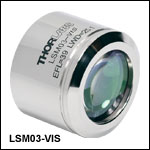
 Zoom
Zoom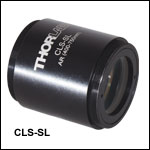
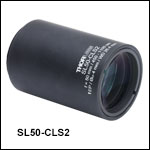
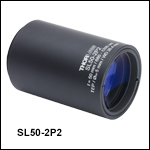
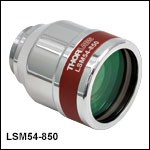


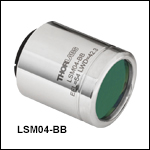
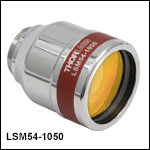

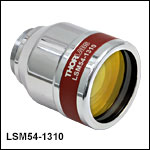

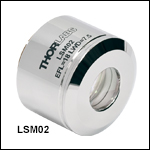


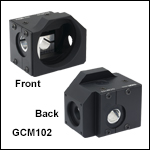

 Scan (Telecentric) Lenses
Scan (Telecentric) Lenses